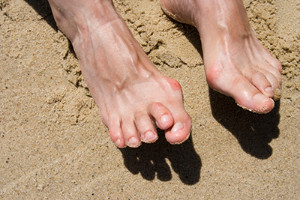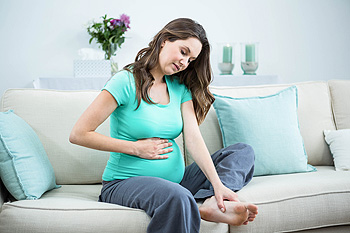Oceanside (760) 630-9200
September 2019
Certain Medical Conditions May Cause Hammertoe
 A hammertoe is considered to be a deformity of the foot. It is also referred to as a “contracted toe” and is most likely noticed on the second and third toes. In severe cases, it can resemble a hammer, because the middle joint in the second toe bends in a downward direction. This deformity can happen for a variety of reasons. These can include having high arches, wearing shoes that do not have adequate room for the toes to move freely in, and prior toe injuries. Additionally, medical conditions such as arthritis and bunions may play a significant role in developing hammertoe. Mild relief can be found when the toes are gently stretched and wiggled, and it can help to wear shoes that have ample room in the toe area. Patients with a severe case of hammertoe may choose surgery, which can permanently straighten the toe. If you are afflicted with this condition, it is advised that you seek the counsel of a podiatrist who can guide you toward proper treatment options.
A hammertoe is considered to be a deformity of the foot. It is also referred to as a “contracted toe” and is most likely noticed on the second and third toes. In severe cases, it can resemble a hammer, because the middle joint in the second toe bends in a downward direction. This deformity can happen for a variety of reasons. These can include having high arches, wearing shoes that do not have adequate room for the toes to move freely in, and prior toe injuries. Additionally, medical conditions such as arthritis and bunions may play a significant role in developing hammertoe. Mild relief can be found when the toes are gently stretched and wiggled, and it can help to wear shoes that have ample room in the toe area. Patients with a severe case of hammertoe may choose surgery, which can permanently straighten the toe. If you are afflicted with this condition, it is advised that you seek the counsel of a podiatrist who can guide you toward proper treatment options.
Hammertoe
Hammertoes can be a painful condition to live with. For more information, contact Dr. Jeff Brooks from Oceanside Foot & Ankle Center. Our doctor will answer any of your foot- and ankle-related questions.
Hammertoe is a foot deformity that affects the joints of the second, third, fourth, or fifth toes of your feet. It is a painful foot condition in which these toes curl and arch up, which can often lead to pain when wearing footwear.
Symptoms
- Pain in the affected toes
- Development of corns or calluses due to friction
- Inflammation
- Redness
- Contracture of the toes
Causes
Genetics – People who are genetically predisposed to hammertoe are often more susceptible
Arthritis – Because arthritis affects the joints in your toes, further deformities stemming from arthritis can occur
Trauma – Direct trauma to the toes could potentially lead to hammertoe
Ill-fitting shoes – Undue pressure on the front of the toes from ill-fitting shoes can potentially lead to the development of hammertoe
Treatment
Orthotics – Custom made inserts can be used to help relieve pressure placed on the toes and therefore relieve some of the pain associated with it
Medications – Oral medications such as anti-inflammatories or NSAIDs could be used to treat the pain and inflammation hammertoes causes. Injections of corticosteroids are also sometimes used
Surgery – In more severe cases where the hammertoes have become more rigid, foot surgery is a potential option
If you have any questions please contact our office located in Oceanside, CA . We offer the newest diagnostic and treatment technologies for all your foot and ankle needs.
It's Time for Beautiful Feet
Foot Care for Pregnant Women
The natural weight that pregnant women gain causes their center of gravity to be completely altered. This causes them to have a new weight-bearing stance which adds pressure to the knees and feet. As a result, pregnant women often experience severe foot pain. The two most common foot issues experienced by women in their pregnancies are edema and over-pronation. It is important for all pregnant women to learn more about how to take care of their feet so they are more comfortable during their pregnancy.
Over-pronation, which is commonly referred to as flat feet, is caused when a person’s arch flattens out upon weight bearing. This causes the person’s feet to roll inward while walking. Pregnant women often experience this due to the sudden weight they gain.
Edema, also referred as swelling in the feet, typically occurs in the later part of the pregnancy. It is the result of the extra blood accumulated in the pregnant woman’s body. The enlarged uterus puts more pressure on the blood vessels in the pelvis which causes leg circulation to slow down. This causes blood to pool in the lower extremities.
Fortunately, there are ways to treat both edema and over-pronation. Edema can be treated by elevating the foot as often as possible. Wearing proper fitting footwear will also be helpful for those with edema. A treatment method for over-pronation could be orthotics. Orthotic inserts should be designed with appropriate arch support and medial rear foot for your foot.
It is best for pregnant women to buy new shoes during the day, because this is the time where swelling is at its peak. Pregnant women also shouldn’t rush when buying shoes. It is always advised that you make sure your shoes fit properly but this is especially important during pregnancy.
If you are a pregnant woman, you should consult with a podiatrist in order to make sure your feet are healthy throughout the entirety of your pregnancy.
Do Feet Become Larger During Pregnancy?
 Many pregnant women notice their feet become larger as their pregnancy develops. This is often a result of additional weight gain caused by the growing fetus. Changes in hormone levels may cause the joints in the feet to become loose. Swollen feet are a common symptom that affect many pregnant women. Mild relief can be found while resting and elevating the feet. Additionally, it may be beneficial to perform gentle foot stretches, and this can be helpful in reducing excess fluid that may accumulate in the feet. It is important to wear shoes that fit correctly, and can offer the correct amount of support. Some pregnant women find it helpful to wear compression stockings in addition to wearing insoles, as they can add to the support of the shoe. If you have questions about how pregnancy affects the feet, please consult with a podiatrist who can provide you with the best information and recommendations.
Many pregnant women notice their feet become larger as their pregnancy develops. This is often a result of additional weight gain caused by the growing fetus. Changes in hormone levels may cause the joints in the feet to become loose. Swollen feet are a common symptom that affect many pregnant women. Mild relief can be found while resting and elevating the feet. Additionally, it may be beneficial to perform gentle foot stretches, and this can be helpful in reducing excess fluid that may accumulate in the feet. It is important to wear shoes that fit correctly, and can offer the correct amount of support. Some pregnant women find it helpful to wear compression stockings in addition to wearing insoles, as they can add to the support of the shoe. If you have questions about how pregnancy affects the feet, please consult with a podiatrist who can provide you with the best information and recommendations.
Pregnant women with swollen feet can be treated with a variety of different methods that are readily available. For more information about other cures for swollen feet during pregnancy, consult with Dr. Jeff Brooks from Oceanside Foot & Ankle Center. Our doctor will attend to all of your foot and ankle needs.
What Foot Problems Can Arise During Pregnancy?
One problem that can occur is overpronation, which occurs when the arch of the foot flattens and tends to roll inward. This can cause pain and discomfort in your heels while you’re walking or even just standing up, trying to support your baby.
Another problem is edema, or swelling in the extremities. This often affects the feet during pregnancy but tends to occur in the later stages.
How Can I Keep My Feet Healthy During Pregnancy?
- Wearing orthotics can provide extra support for the feet and help distribute weight evenly
- Minimize the amount of time spent walking barefoot
- Wear shoes with good arch support
- Wear shoes that allow for good circulation to the feet
- Elevate feet if you experience swelling
- Massage your feet
- Get regular, light exercise, such as walking, to promote blood circulation to the feet
If you have any questions please feel free to contact our office located in Oceanside, CA . We offer the newest diagnostic and treatment technologies for all your foot and ankle needs.






